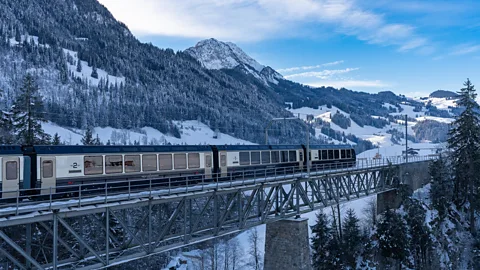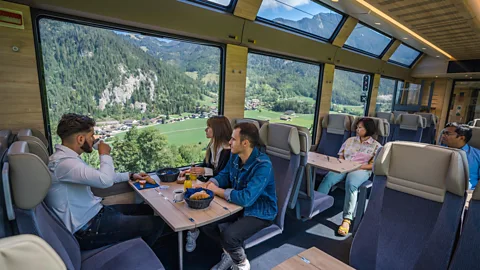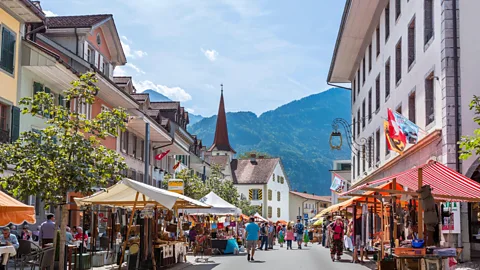
Europe's stunning high-tech luxury train
Tracing a medieval trade route through the Swiss Alps and valleys, the GoldenPass Express isn't just one of the world's most scenic train rides; it's an engineering marvel.
As I sink into the plush, cream-coloured leather recliner, a glass of Champagne in hand and hiking boots raised, I'm ready for a three-hour spectacle where nature takes centre stage. But the stage isn't just in front of me – it's all around.
I'm not in a theatre; I'm in Switzerland aboard the GoldenPass Express: a state-of-the-art panoramic train where floor-to-ceiling windows reveal stunning views of the Swiss countryside – from turquoise lakes that mirror towering mountain peaks to rolling meadows dotted with storybook chalets – that rival the grandest cinematic experiences. Sitting in the nine-seat Prestige Class carriage in a specially designed heated, swivelling chair feels both private and personal – as if I've got the snowcapped Alps, wildflower-laced pastures and bell-adorned cows to myself.
Opened in December 2022 and fully relaunched in June 2023 after addressing problems with track wear, The GoldenPass Express (GPX) is one of Europe's newest (and most luxurious) high-tech trains. Its 115km journey follows a medieval trade route connecting Interlaken's glaciers to Montreux's terraced vineyards, and thanks to a technological innovation, the GPX allows travellers to take one of the world's most scenic train routes without transferring, as passengers did previously
The GPX is one of five premium panoramic trains within the Swiss Travel System. Individual tickets range from 56-145 Swiss francs (roughly £50-130). It's also included in the Swiss Travel Pass (starting from 244 Swiss francs – roughly £219 – and children under 16 ride free of charge) which offers unlimited access to all public transportation (trains, trams, buses and passenger ferries), 50% off mountain railways and gondolas, and free admission to more than 500 museums.
The train's midnight-blue exterior and classic design evoke the bygone era of the original Orient Express that still connects Paris to Istanbul. Inside, the interior is crisp 
As I sink into the plush, cream-coloured leather recliner, a glass of Champagne in hand and hiking boots raised, I'm ready for a three-hour spectacle where nature takes centre stage. But the stage isn't just in front of me – it's all around.
I'm not in a theatre; I'm in Switzerland aboard the GoldenPass Express: a state-of-the-art panoramic train where floor-to-ceiling windows reveal stunning views of the Swiss countryside – from turquoise lakes that mirror towering mountain peaks to rolling meadows dotted with storybook chalets – that rival the grandest cinematic experiences. Sitting in the nine-seat Prestige Class carriage in a specially designed heated, swivelling chair feels both private and personal – as if I've got the snowcapped Alps, wildflower-laced pastures and bell-adorned cows to myself.
RAIL JOURNEYS
Rail Journeys is a BBC Travel series that celebrates the world's most interesting train rides and inspires readers to travel overland.
Opened in December 2022 and fully relaunched in June 2023 after addressing problems with track wear, The GoldenPass Express (GPX) is one of Europe's newest (and most luxurious) high-tech trains. Its 115km journey follows a medieval trade route connecting Interlaken's glaciers to Montreux's terraced vineyards, and thanks to a technological innovation, the GPX allows travellers to take one of the world's most scenic train routes without transferring, as passengers did previously.
Advertisement
The GPX is one of five premium panoramic trains within the Swiss Travel System. Individual tickets range from 56-145 Swiss francs (roughly £50-130). It's also included in the Swiss Travel Pass (starting from 244 Swiss francs – roughly £219 – and children under 16 ride free of charge) which offers unlimited access to all public transportation (trains, trams, buses and passenger ferries), 50% off mountain railways and gondolas, and free admission to more than 500 museums.
The train's midnight-blue exterior and classic design evoke the bygone era of the original Orient Express that still connects Paris to Istanbul. Inside, the interior is crisp and cutting-edge, the Prestige Class specially designed chairs are by Ferrari-designer firm Pininfarina and are the only such rail seats in Europe. Need lower back support? There's a button for that. Tired feet? Elevate your legs. Feeling chilly? Just press the seat warmer. Want a different view? Simply pivot your seat to face the direction of your choice. Just don't fall asleep!
But what truly sets the GPX apart from other luxury trains is something you can't see: it can seamlessly jump between tracks of different gauges and voltages.
Built by Montreux-Oberland-Bernois Railway (MOB) in collaboration with BLS AG (BLS) in Bern, the train winds its way down from the heights of the Bernese Alps, passing the luxurious town of Gstaad, beloved by A-listers for its exclusivity and isolation, and Château d'Oex, famous for its hot air balloon festival (25 January-2 February 2025), before snaking through vineyards as it makes its dramatic descent towards the Vaudois Riviera. Finally, it reaches sun-soaked Montreux, where palms sway on the glistening shores of Lake Geneva.
In 1905, when MOB set out to build the GoldenPass line, the aim was to connect Francophone Montreux to German-speaking Interlaken – two big touristic and economic hubs – with a single trainline. But somewhere along the way, MOB noticed the rail wasn't the same width; the gauges varied. It took 120 years to find a system bridging the gap.
Alamy
The GoldenPass line was created to link Interlaken with Montreux (Credit: Alamy)
The world's railroads use a patchwork of varying gauges – mainly broad, standard and narrow. Railway development lacked industry standards in the 19th Century, leading to varied gauges to suit terrain, transport purpose and political influences. This is one of the main reasons why we often need to change trains when we're travelling.
As Trains magazine senior editor David Lassen tells the BBC, "countries slow to settle on a single gauge paid the price with operating challenges". Case in point: Switzerland.
The idea of directly connecting Lake Geneva to Lakes Thun and Brienz in Interlaken dates to the late 1800s. Since 1916, the Lucerne-Interlaken-Zweisimmen-Montreux route, known as the GoldenPass line, allowed travel between these destinations, but required two train changes because of the tracks' differing gauges. In 1928, the concept of adding a third rail was discussed.